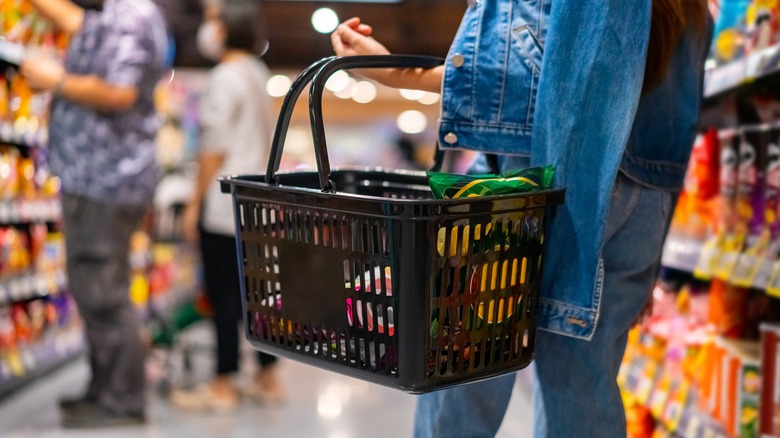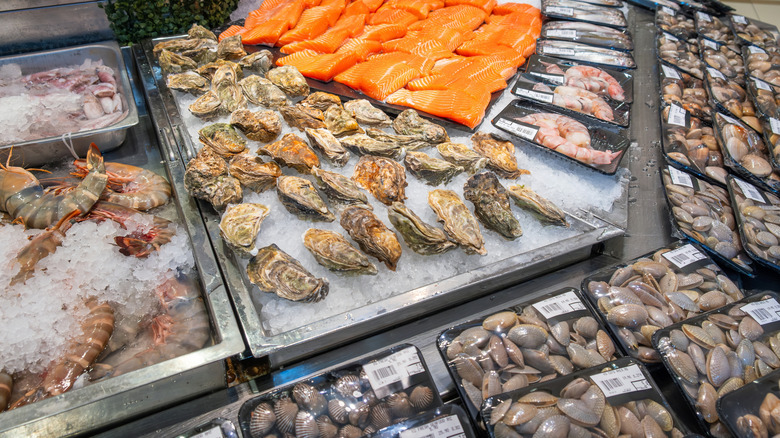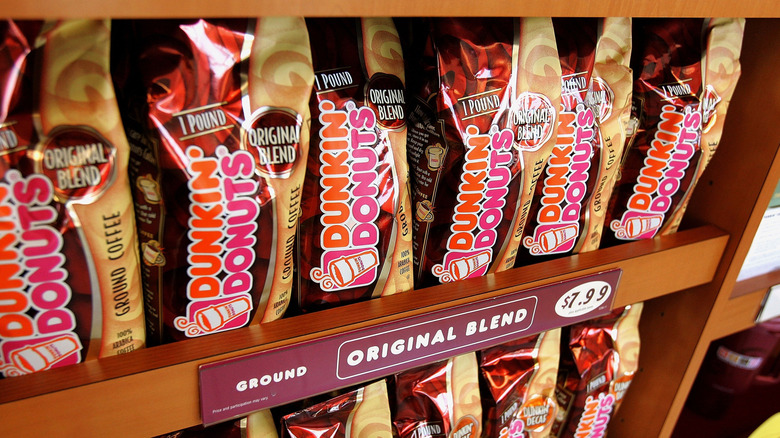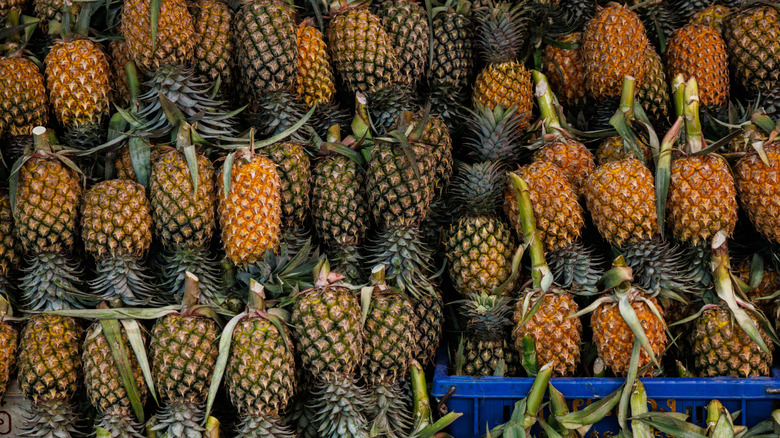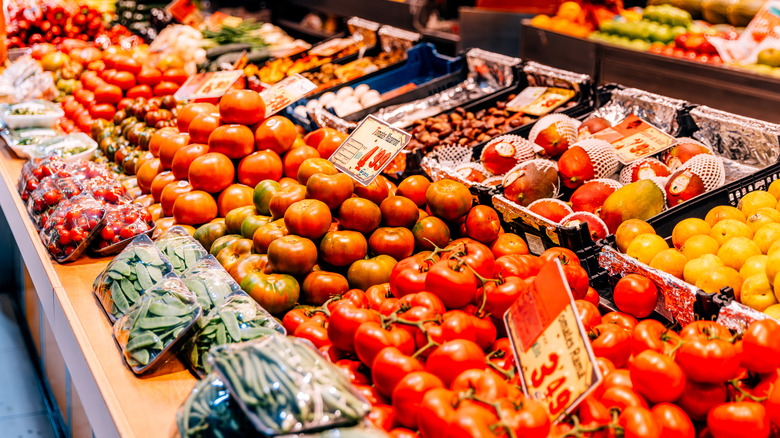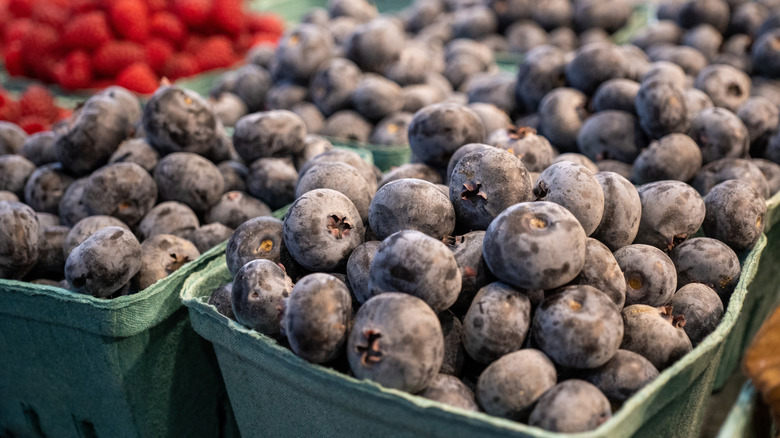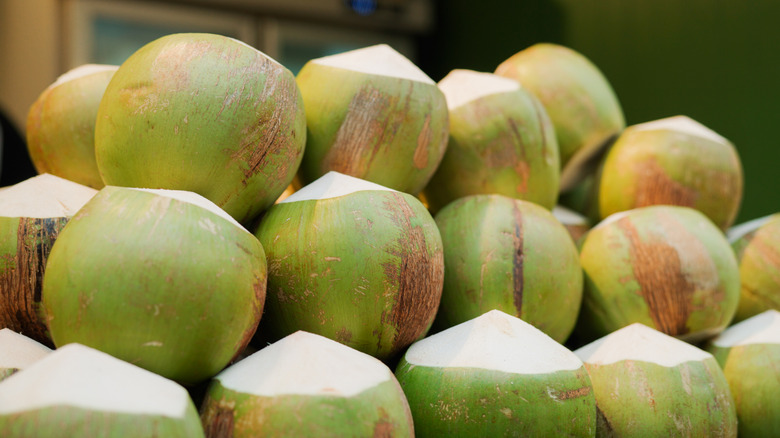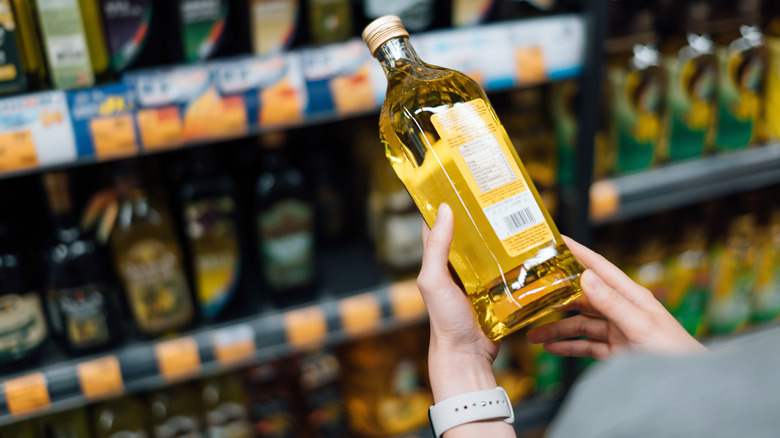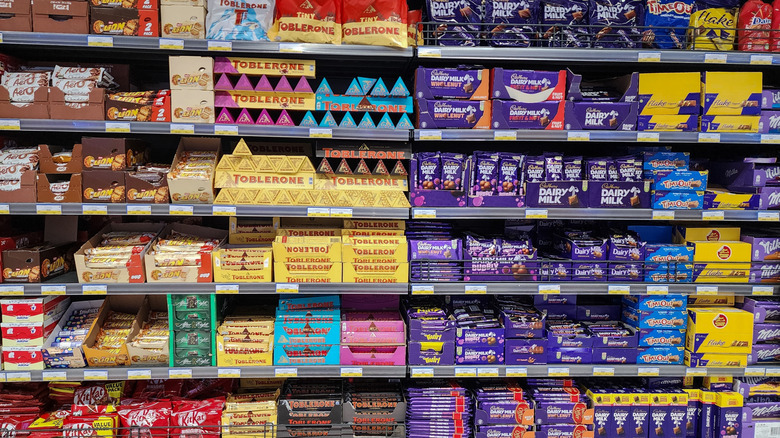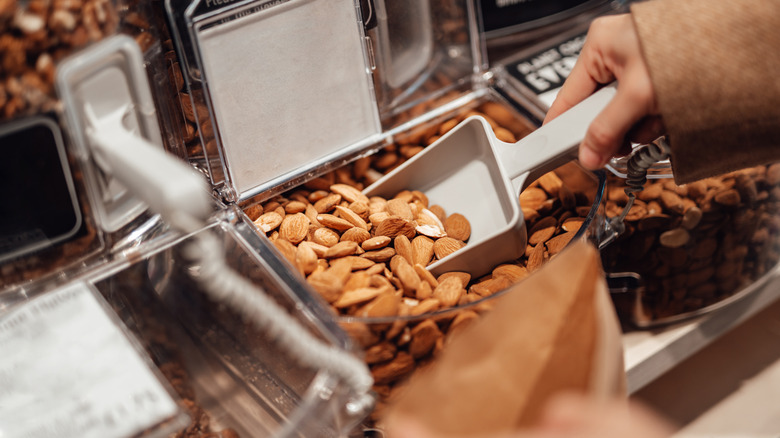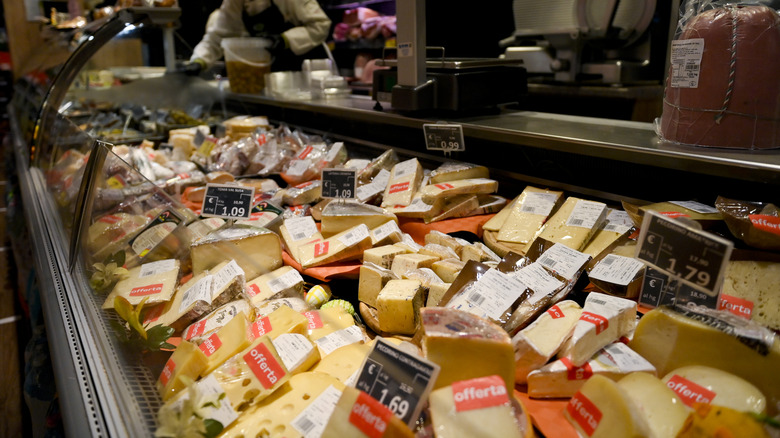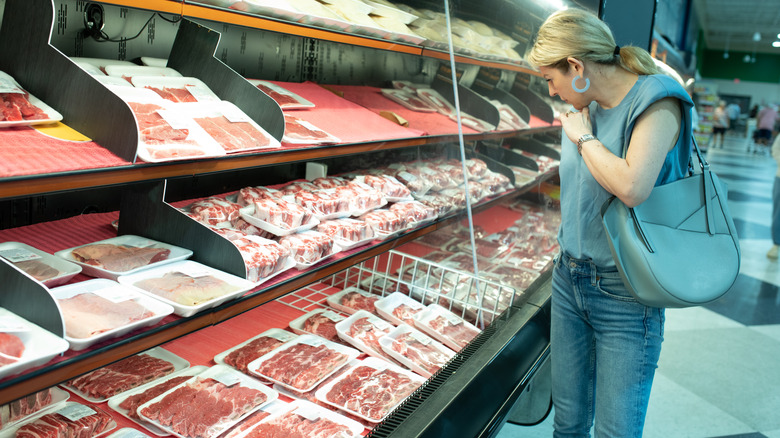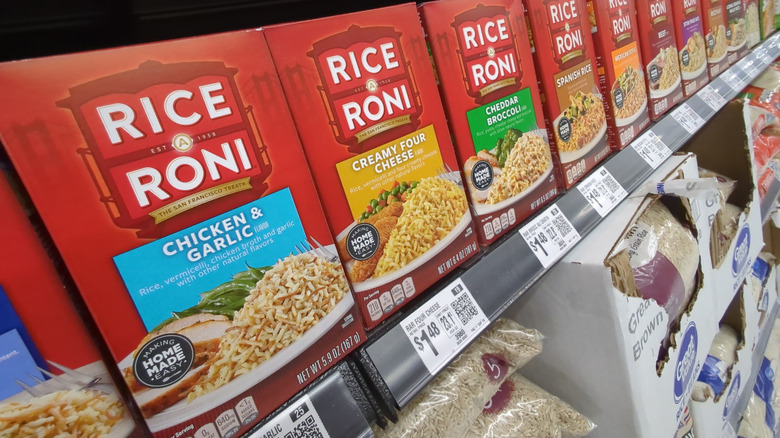14 Foods That Are Most Likely To Be Impacted By Tariffs
It seems like every day in the U.S. news, more headlines are taken up by the latest on all things tariffs. In early April, President Donald Trump introduced a bevy of new tariff rates, with a baseline 10% tariff on pretty much all imported goods, but significantly higher tariffs on goods sourced from specific countries. Some of the highest tariff rates? Tariff rates of more than 40% will be imposed on goods coming from Vietnam, Cambodia, Sri Lanka, Laos, Madagascar, Myanmar, and Syria, with many, many more countries facing tariff rates slightly lower but no less exceptionally high.
As a result, many Americans are expecting prices to rise. A Reuters survey conducted a few days after the tariff rates were announced found that nearly ¾ of respondents expected prices for everyday items would increase over the next six months. Unfortunately, some of those everyday items are groceries — and when grocery prices are already high, that could leave some shoppers reconsidering what they add to their grocery carts in the near future.
If you're among them, these are some of the top foods that are most likely to be impacted by tariffs. Chosen foods are based on factors such as tariff rates for individual countries and whether or not those countries are major suppliers to the U.S., for various foods. Published economic research and insights have also been taken into consideration.
Seafood
About 80% of the seafood that U.S. consumers buy is imported, with major importers being Canada, Chile, India, Indonesia, and Vietnam, according to the U.S. Department of Agriculture. Some feel that's a good thing; imported seafood drives the cost of seafood down, which means more Americans are eating seafood and reaping the health benefits that follow. Unfortunately, though, the price for imported seafood may increase soon, thanks to high tariff rates on major importers like Vietnam (46%), India (26%), and Indonesia (32%).
It's not just foreign-sourced seafood that could possibly be impacted in the months to come, though. American lobstermen, for example, have to often send their lobster to Canada for processing, as the country has far greater processing capacity. If Canada eventually faces processing-related tariffs, then the price of Maine lobster could rise, too, just like the price of Vietnam-sourced catfish and India-sourced shrimp. While some argue that this shift in pricing on catfish and shrimp could drive Americans to buy more U.S.-sourced fish and seafood, it could, in contrast, drive Americans not to buy these ingredients at all.
Coffee
You may have recently seen your local coffee shops and roasters posting on social media about rising costs and prices in the near future. Already, coffee was one of the items at the grocery store selling for a higher than normal price, due in part to supply chain issues and climate change making for poor growing conditions in major coffee-producing countries like Brazil. In some cases, the price of coffee has risen by more than 80% since 2020, according to the U.S. Bureau of Labor Statistics.
Now, though, it's expected that the price of coffee will increase even further. America imports nearly the entirety of its coffee, 99%, per the National Coffee Association. Much of that coffee comes from countries like India, Indonesia, and Vietnam, which are all facing high tariffs over President Trump's base 10% tariff rate on all goods. Even if you only drink Brazilian-sourced coffee, impacted by Brazil's 10% tariff rate, you may still see the cost of your coffee go up by a similar 10%.
Tropical fruit
There are a lot of fruits you can buy locally or even grow at home, but some of America's favorite fruits — like tropical fruits — are largely imported. Take, for example, bananas. The Banana Association of North America is warning that the total cost of bananas nationwide could go up by $250 million per year due to even just a 10% tariff rate. The large majority of bananas in the United States are sourced from Colombia, Costa Rica, Ecuador, Guatemala, and Honduras.
Meanwhile, a Rabobank report estimated that overall costs for tropical fruits like bananas, pineapples, mangoes, and papayas could see increases in retail prices by as much as 18%, year over year. Additionally, Toni Farmer, professor at the University of Pennsylvania, theorized in an educational Instagram post that coconuts will likewise go up in price.
Avocados
Potential tariff rates for Mexico and Canada have been in flux, but one thing's for sure: If President Trump ends up moving forward with greater tariffs on Mexican goods, you might not be ordering extra guac on your Chipotle burrito much longer. The guac is going to be extra — a whole, whole lot extra.
The Council on Foreign Relations put together a study on how tariffs could impact avocados in particular. The study theorizes that, prior to tariffs, a U.S. grocery store could import avocados for $1 and then sell them to consumers for $1.50. However, if a 25% tariff on Mexico goods is imposed (and 90% of American-consumed avocados do come from Mexico), that could raise the cost of each imported avocado by $0.25, a fee likely to be passed on to the consumer, meaning your avocado will then be $1.75. While this doesn't seem like a big deal at first glance, consider that it's still about a 17% increase in retail price — and if your entire grocery budget is going up by 17% or even more, that is definitely a big deal.
Tomatoes
While current tariffs may not be impacting avocados just yet, they are definitely impacting tomatoes. Unless something changes, starting July 14, 2025, Mexican-imported tomatoes will face an import duty of more than 20%. The hope is supposedly that this will make domestically grown tomatoes more attractive to buyers, as the Mexican tomatoes will be higher in price, closer to that of domestically grown tomatoes. Unfortunately, what this will likely probably mean is that all tomatoes will just be more expensive, and tomatoes and tomato products may become a luxury for some American shoppers. In fact, it's estimated that tomatoes could rise in price by as much as 50% starting later this year, (via Mexico Business News).
Unfortunately, tomatoes are the second-consumed vegetable (yeah, yeah, we all know it's a fruit, but bear with us on this) in the United States, after potatoes, according to the U.S. Department of Agriculture. Americans will have to get creative when one of their most-consumed produce items skyrockets in price.
Blueberries
Every budget-savvy grocery shopper has probably bemoaned, at least a time or two, the high price of berries at the grocery store. However, those prices could become at least a little higher in the near future, and not necessarily due to foreign imports. Similarly to how tariffs could inadvertently increase the price of American-caught lobster due to the industry's need to send lobster to Canada for processing, tariffs could also impact American berry-growers so that they need to raise their prices, as well.
For example, some Washington State blueberry farms similarly send their blueberries to British Columbia for processing. If Canadian tariffs were put into place, then the growers that do this could be required to pay tariffs to both send their blueberries to Canada for processing, but then also pay tariffs to bring their blueberries back into the state. Meanwhile, Vietnam, Japan, Malaysia, and Taiwan are the country's largest importers of frozen, fresh, and dried blueberries, and those countries are facing tariffs ranging from 24% to 46%.
Coconuts
While we briefly mentioned coconuts among the various tropical fruits that are likely to be impacted by tariffs, the mighty coconut and its various byproducts deserve their own mention. For example, coconut milk imported from Thailand will be impacted by a nearly 40% tariff rate. Not only is this going to result in increased costs for consumers, but it also poses a problem for small local grocery stores that rely on getting most of their stock imported from countries in Asia — countries that are seeing largely the highest new tariff rates.
We're talking, of course, about your neighborhood Asian grocery store. Owners of such stores have already told publications like NPR that they're seeing rising prices on Thailand-sourced items, like coconut milk and rice. This direct impact on such businesses, NPR also reported, has caused some researchers to predict that rising grocery prices caused by tariffs like these may hit minority communities the hardest.
Meanwhile, though, some Asia-Pacific importers are seeing opportunity. For example, the Philippine's Trade Secretary told BusinessWorld that, now, the country is hoping to expand its coconut exports as, while the Philippines is still facing a 17% tariff rate, Thailand is now facing a larger tariff rate, which could give the Philippines an edge.
Olive oil
Industry analysts are expecting olive oil prices to continue to rise, as the European Union anticipates higher tariff rates on nearly all goods exported to the United States. According to the U.S. Department of Agriculture, the United States accounts for more than 15% of the world's olive oil consumption, but only produces about 2% of its own olive oil. The rest of its olive oil primarily comes from Europe, including Spain, Italy, and Greece. Olive oil prices were already high due to poor growing conditions, and hiked tariff rates on these oil-producing countries are only likely to drive prices higher.
Some, though, are hoping to avoid this fact. For example, some producers in Spain are considering expansion into the United States so they can avoid tariffs. Meanwhile, others are wondering if the increasing price of olive oil leaves an opportunity for consumers to turn to different oils — like seed oils, which have been given a bad rep because they're often found in generally unhealthful foods like deep-fried and highly processed foods. However, seed oils can be part of a healthful diet when consumed in healthful manners, such as when used for stir-frying or oven-roasting. Seed oils — including soybean oil, cottonseed oil, sunflower seed oil, canola oil, rapeseed oil, and peanut oil — can all be produced in the United States.
Chocolate
The Ivory Coast and Ghana supply the world with its majority of cocoa beans, and the two countries are now looking at tariff rates between 10% and 21%. Meanwhile, Indonesia and Malaysia, with their tariff rates of 32% and 24%, respectively, are the top suppliers of cocoa butter. These factors, combined with supply chain issues fueled by climate change, partially inspired Lindt's CEO to tell CNBC that the price of chocolate will likely never go down to what it was in the past. Last year alone, cocoa prices rose by 180%.
In some cases, this has caused buyers to stop purchasing as much chocolate, viewing the treat as just that rather than a necessity to add to the grocery cart — and, of course, this has an impact on producers. In fact, last year, Hershey had already experienced its worst profit in seven years. In other instances, small chocolate producers have recently been forced out of business. Both large and small chocolate producers are admitting that they have to pass on tariff costs to their customers.
Nuts
While, yes, the United States produces a fair number of nuts, such as almonds from California, it also imports a fair number of nuts from countries and areas that will face high tariffs, such as Vietnam, the Ivory Coast, Brazil, and Thailand, including cashews, pecans, and macadamia nuts. Vietnam in particular sends a good amount of cashews to the United States.
However, it's also worth considering that some countries will be putting retaliatory tariffs in place that affect products that the United States exports, such as nuts, and that could impact grocery shoppers at home. For example, Canada said that it could potentially place a retaliatory tariff on almonds, hazelnuts, pistachios, and walnuts. We've already seen how retaliatory tariffs can negatively impact food industries, when, in 2018, the United States increased certain tariffs and, as a result, the United States tree nuts industry experienced a loss of $239 million. The California almond industry is currently considering the impacts of a potential trade war, theorizing that such an event could cause many American almond orchards and farms to shutter.
Alcohol
If your favorite drink of choice is a nice Mexican tequila, Scottish whiskey, European wine, or European beer, you may want to change up your drinking habits in the near future or reshuffle your budget around, if possible. One retailer told CBS, regarding European wines, that, while the tariff on European wines may be 20%, prices will likely go up 30%, with every business along that wine's supply chain marking up their fees accordingly. If you prefer South African wines, the cost will be even more, due to higher tariffs.
Beyond just the country-specific tariffs, other specific tariffs can influence the drinks industry in other ways, such as aluminum tariffs that could impact canned beer. Additionally, just as is the case with tariffs putting small chocolatiers out of business, small distilleries and wineries that export to the United States will likely feel the brunt of the tariffs the most, while some entire international alcohol industries may not be able to recover from a loss of the American market, as is the case with the Spanish wine market and French brandy market.
Cheese
Your next charcuterie board may feature a lot more cheddar from Wisconsin and Vermont than brie or gorgonzola from Europe. Imported cheeses from Europe will be impacted by the tariffs imposed on the European Union, with importers saying they must pass on the costs of those tariffs to consumers in order to stay in business — even if that means they sell overall less cheese. Some small businesses that offer specialty imported cheeses theorize, though, that increased prices could drive customers away completely, sending them to the grocery store to buy American-made cheeses rather than imported cheeses — or, in at least one positive, they may be more inclined to seek out small, American, artisanal cheese producers.
This increase in cost isn't just affecting small businesses in the United States, though. One small business cheesemaker in the United Kingdom told BBC that they make about 10% of their revenue from exporting to the United States, and that they expect tariffs will make their products 10% more expensive, resulting in less business overall.
Beef
While the United States isn't as reliant on other countries for beef as it is, say, coffee or coconuts, it does import a fair number of cattle from Mexico and Canada, as well as Australia and New Zealand. Tariffs on these countries will likely raise the cost of imported beef — and some American farmers hope that fact inspires shoppers to avoid imported beef in favor of American beef.
U.S. farmers will certainly need Americans to pick up the slack. China is a huge market for American-raised beef and 125% retaliatory tariffs from the country has increased prices of U.S. beef in China. In response, Chinese restaurants are switching from American-raised beef to Australian-raised beef. Meanwhile, American farmers will also be dealing with the impact tariffs are going to have on farming equipment, with many machinery parts sourced from abroad. As such, if American shoppers want to support American farmers in the months ahead, they may just have to swallow a more expensive burger.
Rice
Similarly to beef, America doesn't majorly rely on other countries for all its rice. However, it does import about ⅓ of all American-consumed rice, according to the U.S. Department of Agriculture, primarily jasmine rice from Thailand and basmati rice from India and Pakistan. With Thailand facing 36% tariff rates and India facing 26% tariff rates, this could really drive up the cost of jasmine and basmati rice — by as much as ⅓ or more, one unnamed industry source told Food Business News, while also acknowledging that tariffs could make way for domestic rice to fill in the gaps.
Currently, the United States grows rice in the Southeast and on the West Coast, with some of that rice accounting for approximately 80% of the country's rice consumption, and the rest of it exported to countries like Mexico, Canada, Central America, and Japan. In part of the back-and-forth tariff negotiations between the United States and other countries, Japan has actually considered increasing its importation of American rice; in the past, President Trump accused Japan of imposing a 700% tariff on American rice imports, a number that Japan contested.
